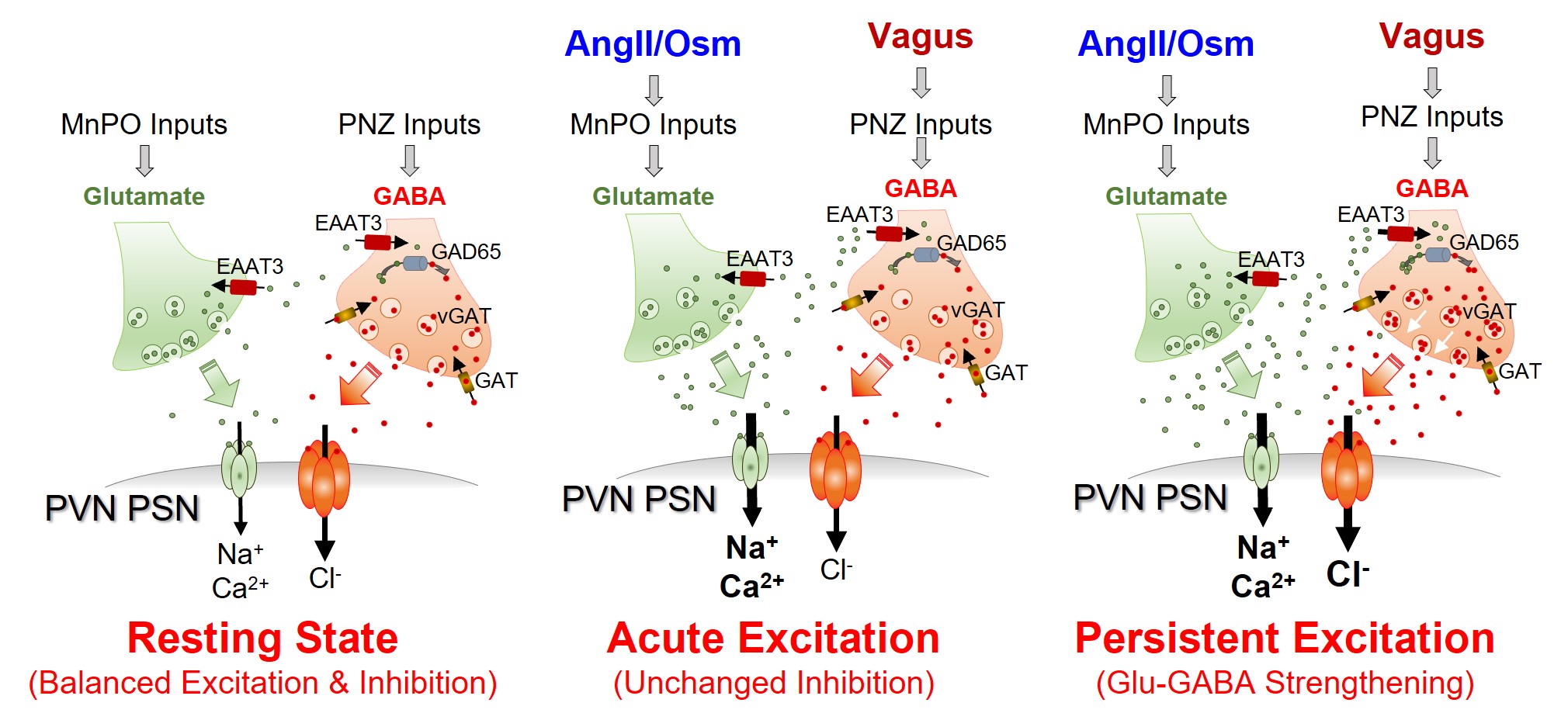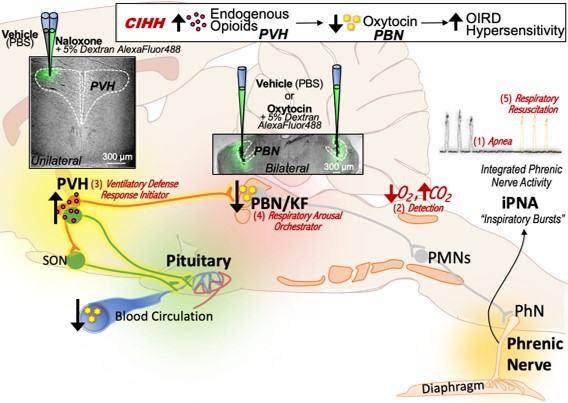Glenn M. Toney, PhD, FAHA, FAPS

Department Head
Professor
Contact
Medical Physiology
8447 John Sharp Pkwy,
1342 Medical Research and Education Building 2
Bryan,
TX
77807
toney@tamu.edu
Phone: 979.436.9266
Education and Training
- Weber State University, BS, Zoology, 1988
- University of Louisville, Ph.D., Physiology, 1992
- University of Texas Health Science Center at San Antonio, Postdoctoral Training, 1996
Representative Publications
- Peripheral macrophages contribute to nociceptor priming in mice with chronic intermittent hypoxia.Chivers SB, Andrade MA, Hammack RJ, Shannonhouse J, Gomez R, Zhang Y, Nguyen B, Shah P, Kim YS, Toney GM and Jeske NA.Sci Signal. 2024 Jul 30;17(847):eadn8936. doi: 10.1126/scisignal.adn8936. Epub 2024 Jul 30. PMID: 39078919
- Glutamate Spillover Dynamically Strengthens Gabaergic Synaptic Inhibition of the Hypothalamic Paraventricular Nucleus. Yamaguchi J, Andrade MA, Truong TT and Toney GM. J Neurosci. 2024 Feb 14;44(7):e1851222023. doi: 10.1523/JNEUROSCI.1851-22.2023. PMID: 38154957
- Presence of a remote fear memory engram in the central amygdala. Hammack RJ, Fischer VE, Andrade MA and Toney GM. Learn Mem. 2023 Oct 6;30(10):250-259. doi: 10.1101/lm.053833.123. Print 2023 Oct. PMID: 37802546
- Anterior basolateral amygdala neurons comprise a remote fear memory engram. Hammack RJ, Fischer VE, Andrade MA and Toney GM. Front Neural Circuits. 2023 Apr 27;17:1167825. doi: 10.3389/fncir.2023.1167825. eCollection 2023. PMID: 37180762
- Early central cardiovagal dysfunction after high fat diet in a murine model. Strain MM, Espinoza L, Fedorchak S, Littlejohn EL, Andrade MA and Toney GM, Boychuk CR.Sci Rep. 2023 Apr 21;13(1):6550. doi: 10.1038/s41598-023-32492-w. PMID: 37085567
- Chronic intermittent hypoxia enhances glycinergic inhibition in nucleus tractus solitarius. Jia S, Rybalchenko N, Kunwar K, Farmer GE Jr, Little JT, Toney GM and Cunningham JT.. J Neurophysiol. 2022 Dec 1;128(6):1383-1394. doi: 10.1152/jn.00241.2022. Epub 2022 Nov 2. PMID: 36321700
- Local ionotropic glutamate receptors are required to trigger and sustain ramping of sympathetic nerve activity by hypothalamic paraventricular nucleus TNFα. Mourão AA, Shimoura CG, Andrade MA, Truong TT, Pedrino GR and Toney GM. Am J Physiol Heart Circ Physiol. 2021 Sep 1;321(3):H580-H591. doi: 10.1152/ajpheart.00322.2021. Epub 2021 Aug 6. PMID: 34355986
- Oxytocin Receptor Activation Rescues Opioid-Induced Respiratory Depression by Systemic Fentanyl in the Rat. AD and Toney GM. J Pharmacol Exp Ther. 2021 Aug;378(2):96-107. doi: 10.1124/jpet.121.000535. Epub 2021 May 14. PMID: 33990416
- High dietary salt amplifies osmoresponsiveness in vasopressin-releasing neurons. Levi DI, Wyrosdic JC, Hicks AI, Andrade MA, Toney GM, Prager-Khoutorsky M and Bourque CW. Cell Rep. 2021 Mar 16;34(11):108866. doi: 10.1016/j.celrep.2021.108866. PMID: 33730577
- Intermittent hypercapnic hypoxia induces respiratory hypersensitivity to fentanyl accompanied by tonic respiratory depression by endogenous opioids. Brackley AD, Andrade MA and Toney GM. J Physiol. 2020 Aug;598(15):3239-3257. doi: 10.1113/JP280021. Epub 2020 Jun 14. PMID: 32415789
- Central AT1 receptor signaling by circulating angiotensin II is permissive to acute intermittent hypoxia-induced sympathetic neuroplasticity. Shimoura CG, Andrade MA and Toney GM. J Appl Physiol (1985). 2020 May 1;128(5):1329-1337. doi: 10.1152/japplphysiol.00094.2020. Epub 2020 Apr 2. PMID: 32240022.
- High Salt Intake Lowers Behavioral Inhibition. Gilman TL, George CM, Andrade MA, Mitchell NC, Toney GM and Daws LC. Front Behav Neurosci. 2019 Dec 13;13:271. doi: 10.3389/fnbeh.2019.00271. eCollection 2019. PMID: 31920580
- Age- and Sex-Specific Plasticity in Dopamine Transporter Function Revealed by Food Restriction and Exercise in a Rat Activity-Based Anorexia Paradigm. Gilman TL, Owens WA, George CM, Metzel L, Vitela M, Ferreira L, Bowman MA, Gould GG, Toney GM and Daws LC. J Pharmacol Exp Ther. 2019 Nov;371(2):268-277. doi: 10.1124/jpet.119.260794. Epub 2019 Sep 3. PMID: 31481515.
- Modulation of extrasynaptic GABAA alpha 5 receptors in the ventral hippocampus normalizes physiological and behavioral deficits in a circuit specific manner. Donegan JJ, Boley AM, Yamaguchi J, Toney GM and Lodge DJ. Nat Commun. 2019 Jun 27;10(1):2819. doi: 10.1038/s41467-019-10800-1. PMID: 31249307
- Glucose-Lowering by Leptin in the Absence of Insulin Does Not Fully Rely on the Central Melanocortin System in Male Mice. Singha AK, Yamaguchi J, Gonzalez NS, Ahmed N, Toney GM and Fujikawa TEndocrinology. 2019 Mar 1;160(3):651-663. doi: 10.1210/en.2018-00907. PMID: 30698681
- Activation of the hypothalamic paraventricular nucleus by acute intermittent hypoxia: Implications for sympathetic long-term facilitation neuroplasticity. Maruyama NO, Mitchell NC, Truong TT and Toney GMExp Neurol. 2019 Apr;314:1-8. doi: 10.1016/j.expneurol.2018.12.011. Epub 2018 Dec 31. PMID: 30605624
- Neuroinflammation Contributes to High Salt Intake-Augmented Neuronal Activation and Active Coping Responses to Acute Stress Gilman TL, Mitchell NC, Daws LC and Toney GM Int J Neuropsychopharmacol. 2019 Feb 1;22(2):137-142. doi: 10.1093/ijnp/pyy099. PMID: 30535261
Research Interests
- Neural Mechanisms of Cardiovascular Regulation: Arterial hypertension (high blood pressure) is the leading cause of death in the United States. Nearly 1 in 3 US adults is hypertensive, with nearly half of these classified as “treatment resistant”. Treatment resistant hypertension is linked to neurogenic mechanisms that increase the persistent level of sympathetic nerve activity (SNA) to cardiovascular end organs. Pre-sympathetic neurons (PSNs) of the hypothalamic paraventricular nucleus (PVN) are essential drivers of increased SNA in multiple pre-clinical models of arterial hypertension. Perhaps the most robust property of PVN PSNs is their resting state of discharge quiescence. Early studies linked resting quiescence of PVN PSNs to the dominance of synaptic inhibition by the brain’s dominant inhibitory neurotransmitter, gamma-aminobutyric acid (GABA). Mechanisms that establish and defend GABA’s inhibitory tonus in the PVN, however, are understood only on a rudimentary level. This is an important knowledge gap because factors that increase PVN-driven SNA in hypertension must ultimately subvert or overwhelm mechanisms that regulate the quiescent resting state of PSNs. Our research funded by the National Heart, Lung, and Blood Institute (NHLBI) and the National Institute for Neurological Disorders and Stroke (NINDS) has uncovered key presynaptic and postsynaptic mechanisms that contribute to hyperactivity of PVN PSNs in several pre-clinical models of arterial hypertension. Ongoing studies further explore these mechanisms and are seeking to translate our findings into improved clinical treatments for hypertension.

- Improving Treatments for Depression and Anxiety: Mood disorders, especially anxiety and depression, are linked to serotonergic dysfunction in limbic regions of the forebrain. Understanding serotonin (5-HT) transmission is, therefore, of fundamental importance to improving treatment for these increasingly prevalent neuropsychiatric disorders. The 5-HT transporter (SERT) clears 5-HT from extracellular fluid with high-affinity and is considered a primary controller of the strength and duration of 5-HT signaling in the brain. Studies spearhead by our collaborator Dr. Lynette Daws at the University of Texas Health Science Center at San Antonio, have established that organic cation transporter 3 (OCT3), a low-affinity, but high-capacity transporter also plays a critical role in 5-HT clearance. Synaptic processing in the basolateral amygdala (BLA) is essential for negative valence, fear-related memories associated with anxiety disorders. BLA receives dense input from 5-HT neurons in the dorsal raphe nucleus (DRN), and BLA principal neurons have numerous fear-regulatory outputs, including dense projections to medial entorhinal cortex (mEC); a gateway for fear memory information flow into and out of the hippocampus. Like SERT, OCT3 is highly expressed in the BLA, ideally positioning these transporters to powerfully control extracellular 5-HT and its local neuro-modulatory efficacy. Our research funded by the National Institute for Mental Health (NIMH) tests the hypothesis that 5-HT clearance by OCT3 and SERT in BLA facilitates acquisition and consolidation of fear memory by buffering the rise of 5-HT that normally restrains BLA-mEC neuronal activation by excitatory fear memory-promoting limbic inputs.

- Overcoming the Opioid Epidemic: The opioid epidemic is a dire ongoing public health crisis, with opioid-induced respiratory depression (OIRD) being the primary cause of fatal overdose. Among the most vulnerable to suffer fatal OIRD are sleep apnea (SA) patients. An under recognized consequence of SA is elevated endogenous opioid activity, which increases respiratory vulnerability. Mechanisms linking elevated endogenous opioids to heightened respiratory arrest by acute opioid use in SA patients are unknown. This is a grave concern because chronic pain is highly prevalent in SA patients, who are more likely to seek prescription (or illicit) opioids. Despite its high clinical significance, the “double hit” in SA patients caused by heightened endogenous opioids (Hit #1) and the taking of exogenous opioids (Hit #2) has not been investigated. We recently reported that oxytocin (OT) receptor (OTR) activation can prevent and reverse fatal OIRD by the most lethal opioid, fentanyl. OT both counters OIRD and reduces the stress hormone cortisol (corticosterone), which is elevated in SA patients and contributes to opioid withdrawal symptoms. In addition, OT mitigates drug-seeking behavior, and induces potent analgesia. Collectively, these actions of OT make it a novel and highly attractive potential treatment for opioid use disorder and fatal OIRD. Our lab and others determined that the hypothalamic paraventricular nucleus (PVH), a key stress and respiratory integration hub, is robustly modulated in animal models of SA. One SA-related affect is reduced OT release from PVH neurons. In our preclinical model that recapitulates the chronic intermittent bouts of hypercapnic hypoxia of SA, heightened endogenous opioid activity confers hypersensitivity to fentanyl OIRD. Our studies funded by the National Institute for Drug Abuse (NIDA) indicate that endogenous opioids in the PVH are required for fentanyl OIRD. This could explain how elevated endogenous opioid signaling in SA confers hypersensitivity in a “double hit” scenario. Our studies are using optogenetic activation and viral gene manipulations to explore the mechanisms whereby PVH OT neurons avert fatal fentanyl-induced OIRD focusing on pontine inspiratory-expiratory phase switching neurons in the parabrachial and Kölliker-Fuse nuclei.
